BlackBerrys to get WiFi this year, too
 I was just saying that WiFi is the key for the expansion of Mobile Web 2.0 software... Nokia, Sony-Ericsson and Motorola have already announced or released WiFi phones, and now it's time for Blackberry.
I was just saying that WiFi is the key for the expansion of Mobile Web 2.0 software... Nokia, Sony-Ericsson and Motorola have already announced or released WiFi phones, and now it's time for Blackberry.

 I was just saying that WiFi is the key for the expansion of Mobile Web 2.0 software... Nokia, Sony-Ericsson and Motorola have already announced or released WiFi phones, and now it's time for Blackberry.
I was just saying that WiFi is the key for the expansion of Mobile Web 2.0 software... Nokia, Sony-Ericsson and Motorola have already announced or released WiFi phones, and now it's time for Blackberry.
 ... to wide-spread adoption of Mobile Web 2.0 software. The presence of WiFi features in mobile will get people free internet access through public hotspots, instead of paying large bills to the operators. In turn, the operators will lower the prices for the paid services (3G/UMTS/HSDPA) and this will open the way to a new round of mobile applications that can concentrate on providing enhanced functionality, while downloading all the data needed using the internet.
... to wide-spread adoption of Mobile Web 2.0 software. The presence of WiFi features in mobile will get people free internet access through public hotspots, instead of paying large bills to the operators. In turn, the operators will lower the prices for the paid services (3G/UMTS/HSDPA) and this will open the way to a new round of mobile applications that can concentrate on providing enhanced functionality, while downloading all the data needed using the internet.
Major phone manufacturers have released this year a few phones with WiFi, and more are coming soon. I'm not talking about Windows Mobile-based PDA/smartphone hybrids, that have had WiFi for some time, I'm talking about "normal-looking" phones. Nokia has the 6136, E60, E61, E70, N80, N91, N92, N93 coming this summer, Sony-Ericsson has the P990, Motorola has the A910 and has just announced the Q.
Currently, the prices for internet access set by the mobile operators are quite high, around $0.5-$1/MB, with flat rates around $50-$100/month. They probably consider it a premium service, especially if it goes through a fast connection — EDGE/234kbps or 3G/UMTS/384kbps are usual these days in GSM networks in Europe. I'm sure this will change soon, even if low-mid-end phones don't get WiFi yet — high-end phone owners are the ones using most internet features and paying the most for them.
After following a referrer in my web server logs, I noticed this: Search for "Google" with the language set to English but cr=countryRO (only pages in Romania). Guess who's #3 in the results, immediately under Google.ro? 
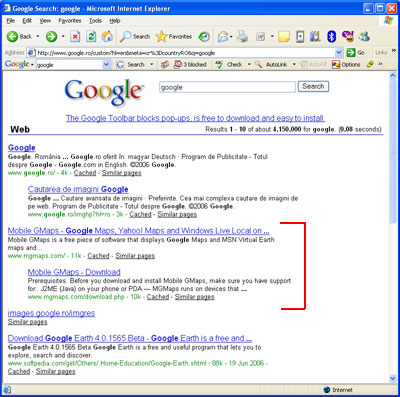
 As expected, Google has updated Maps to contain the latest high-res satellite imagery available in Google Earth v4. Many places of the world are now available in high-res, for example Dubai, Manila or South America. Mobile GMaps was also updated to support the new images.
As expected, Google has updated Maps to contain the latest high-res satellite imagery available in Google Earth v4. Many places of the world are now available in high-res, for example Dubai, Manila or South America. Mobile GMaps was also updated to support the new images.
Google is testing a new "Click for more information" button in search results. Clicking on the "+" button will expand the search result with a few lines containing more information and a Search Site form. See the screenshots below.
Searching for "Google":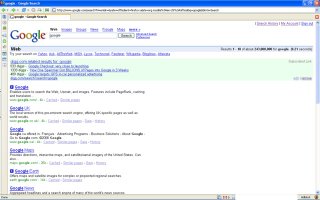
Google Earth expanded:
Google expanded: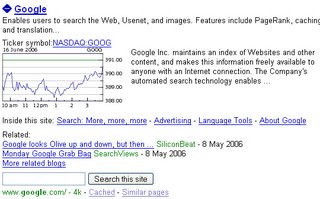
Search results for "hotels":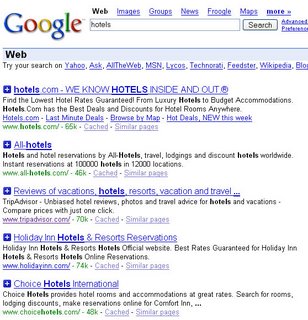
Note: In case you're wondering about the "Save" and "History" links, those are added by the Customize Google Firefox extension.
This just in.
Nokia Corp. and Siemens AG are expected to announce Monday that they are combining their phone equipment units in a deal valued at $31.5 billion, according to a media report Sunday.But wait a minute... wasn't the mobile division of Siemens sold to Benq a year ago? Well, phone equipment units are much more than just mobiles, Siemens has a strong position in landline phone equipments here in Europe. Although this is announced as a merger, the new business will be based in Finland and Nokia will control the board.
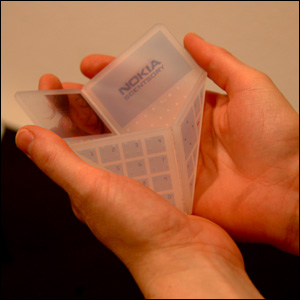 Just look at these phone ideas... They were created by some design students in London sponsored by Nokia. If that's how phones will look in 2015, I just hope there will still be around some of the "ancient" models like the N-Series.
Just look at these phone ideas... They were created by some design students in London sponsored by Nokia. If that's how phones will look in 2015, I just hope there will still be around some of the "ancient" models like the N-Series. 
Brighthand compares iGo, Mapopolis and TomTom in a review of navigation software for Windows Mobile devices, reports Engadget Mobile. There is no clear winner, although TomTom is remarked for its reliability, accuracy, and useful extras.
Compared to Mobile GMaps, all these pieces of software provide more functionality, but let's not forget the drawbacks: they work only on Windows Mobile devices, they cost around $100 or more, they only display maps (vectorial information) and not satellite/aerial imagery. Mobile GMaps works on any Java J2ME-enabled phone or device, it can display both maps and aerial imagery and it is available for FREE — although you may have to pay to your wireless carrier for internet traffic. In addition, it supports both GPS receivers over bluetooth and internal GPS/AGPS features on phones like the Siemens SXG75.
Nvidia has designed a new chip for mobile devices based on Windows Mobile. The chip is named Nvidia 5500, and there are already two smartphones that contain it. Happy mobile 3D gaming!
Google Earth version 4 was launched today. It is a simultaneous release for PC, Mac and Linux platforms that includes more detailed imagery, more coverage, integration with SketchUp, and other cool features. For more details, read the announcement on the Official Google Blog.
Besides these updates, some nice features are coming to Google Maps too. You can now use KML files in Google Maps, you can use the Google Geocoder to geocode addresses in U.S., Canada, Japan, France, Italy, Germany and Spain, and there's Google Maps for Enterprise, a commercial service that allows businesses to map customers, track shipments, or view other data in a geographical context.
 Google has also announced they will soon add more high-res images to Google Maps, so I thought I'd give it a try and see what's new with Maps. To my surprise, some high-res images are already available, they are just not integrated with the Maps interface. To give you a feel of what's coming next, you can do the following. Search for a place on Google Maps, then switch to satellite mode and zoom in to the max. The tile image in the center of the map will be retrieved from an address like:
Google has also announced they will soon add more high-res images to Google Maps, so I thought I'd give it a try and see what's new with Maps. To my surprise, some high-res images are already available, they are just not integrated with the Maps interface. To give you a feel of what's coming next, you can do the following. Search for a place on Google Maps, then switch to satellite mode and zoom in to the max. The tile image in the center of the map will be retrieved from an address like:
http://kh3.google.com/kh?n=404&v=6&t=tqstqrqrrqrtsssssstt.
(I searched for "new york"). I'm not going to detail how the URL is constructed from the latitude & longitude coordinates (I'm saving it for another post), but you can easily see that each letter added to the URL (one of q, r, s or t) zooms in once. So... what happens if you add a letter, say 'r', to the above URL? You are pointed to http://kh3.google.com/kh?n=404&v=6&t=tqstqrqrrqrtssssssttr, which contains a higher-res detail of the top-right part of the previous image! That's a new zoom level, and I expect to see it soon in Google Maps. Until then, the latest version of Mobile GMaps already supports this high-res imagery - see the announcement.
This is interesting... I guess BREW is not dead after all:
"Javaground USA Inc., a leading tool provider for the Java 2 Micro Edition™ (J2ME™) mobile game industry, today introduced a tool that allows game developers to port their applications from the J2ME environment to QUALCOMM's BREW® solution."
If you've used the latest version of Yahoo Messenger, I'm sure you noticed the ads that appear at the bottom of the main window. I find them quite annoying, so if you don't like them either here is the fix: download this file, unzip it then double-click the reg file. Bingo, no more ads. Should you re-install or install a newer version of Y!M, you'll have to run the reg file again.
Are you annoyed by the Blogger NavBar that appears at the top of your blog? It's very easy to remove it, without violating the terms of service. Just add:
#b-navbar {
height:0px;
visibility:hidden;
}
to the style information at the beginning of your template. You'll be left with some space at the top of your blog, above the header, but hat's easy to remove too. I replaced the header with an image and made sure to remove the entire <div id="header">, then I added some space above by changing the style information for the #content div.
The term Web 2.0 seems to be popping up everywhere on the Internet these days. Many new and successful web services belong to the Web 2.0 trend, they support tagging, blogging, collaboration or they are simply more dynamic web applications, giving a better user experience than traditional static web pages.
Meanwhile, on mobile devices, the Mobile Web 1.0 is still about WAP and Java games. WAP, the wireless access protocol was developed as a low-resource solution to browsing, and all of today's mobile phones support it. In addition, most phones come with Java games preinstalled and support additional game downloads. However these features alone are not a solution for today's needs: we need connected mobile software, software that allows the mobile phone or device to interact with other devices or with the Internet. There are a few technologies that could be used by such applications:
>> Java. The aim of Java 2 Micro-Edition (J2ME) was to create a platform to allow portability of mobile applications. In practice, things did not work out as expected, each phone manufacturer added their own extensions to J2ME, so it ended up where it started: non-portable applications. In fact, the portable code was all about (basic) graphics, and that's one of the reasons why most of the J2ME applications are games. Some phone manufacturers even use the Games menu to include all J2ME applications.
Fortunately, networking support was added to J2ME and it is supported on most implementations, and this has caused a new wave of Java applications to appear. Two great examples of such applications are Mobile GMaps and Opera Mini. Opera brings in a web browser in 100kB that is quite fast, supports a subset of CSS and has a very nice user interface. MGMaps is a 40kB application that allows the user to browse maps (provided by Google Maps), perform searches, or find their own position on the map by connecting to a GPS receiver via bluetooth.
>> AJAX — Asynchronous Javascript And XML — is a technique that is widely used in recent web applications. It hides the communication between a client web application and the server, giving an enhanced browsing experience to the user. There is nothing similar on mobile platforms, because mobile browsers are not there yet — there is no mobile browser to support Google Maps, for example. However, there are mobile platforms that have taken some steps towards mobile AJAX, the most notable such product is Opera Platform. Some other people think that mobile AJAX is the key component of Mobile Web 2.0.
>> Symbian, Windows Mobile, Brew or Palm OS. I'm including these together, because they are all proprietary technologies. They all allow rich client applications with enhanced user interfaces, and have a pretty large number of compatible applications. Still there is no common platform for developing applications for all these systems — except for Java!
Which of these will it be? We'll have to wait and see!